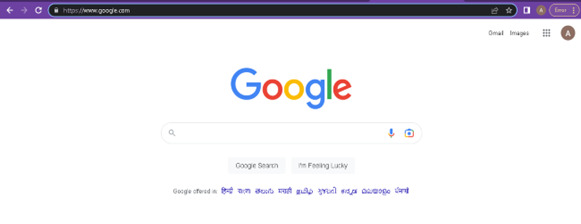
 Data Structure
Data Structure Networking
Networking RDBMS
RDBMS Operating System
Operating System Java
Java MS Excel
MS Excel iOS
iOS HTML
HTML CSS
CSS Android
Android Python
Python C Programming
C Programming C++
C++ C#
C# MongoDB
MongoDB MySQL
MySQL Javascript
Javascript PHP
PHP
- Selected Reading
- UPSC IAS Exams Notes
- Developer's Best Practices
- Questions and Answers
- Effective Resume Writing
- HR Interview Questions
- Computer Glossary
- Who is Who
Create web element driver method in selenium Python
What is Selenium?
One of the most well-known open-source frameworks for automating web browsers is called Selenium. It enables developers and testers to simulate user actions on a web page, such as clicking buttons, filling out forms, and navigating between pages, in order to test web applications or carry out repetitive tasks. For example, this could include clicking "Submit" on a form, clicking "Next" on a page, and so on.
There are a number of programming languages that may be used with Selenium, including Python, Java, C#, and JavaScript. In addition to that, it gives users access to a variety of tools and libraries for interfacing with web browsers like as Chrome, Firefox, Edge, and Safari.
Some key features of Selenium
Cross-browser compatibility ? Selenium supports multiple web browsers, allowing you to test your web application across different platforms and browsers.
Easy to use ? Selenium provides a simple API that allows you to interact with web elements on a page, making it easy to automate repetitive tasks.
Extensible ? Selenium can be extended with custom plugins and libraries, allowing you to add new functionality or customize the framework to meet your needs.
Large community ? Selenium has a large and active community of developers and testers, who share their knowledge and contribute to the development of the framework
Some key uses of Selenium
Automated testing ? Selenium can be used to automate functional and regression tests for web applications, allowing you to test your application quickly and consistently.
Web scraping ? Selenium can be used to extract data from web pages, allowing you to collect data for analysis or research purposes.
Browser automation ? Selenium can be used to automate repetitive tasks in a web browser, such as filling out forms or navigating to specific pages.
Overall, Selenium is a powerful and flexible framework for automating web browsers and testing web applications. It is widely used in the industry and has a strong community of developers and testers who contribute to its ongoing development and improvement.
In this article, we will discuss how to use Python to create a Selenium web element driver method. Using this method, Selenium test scripts are able to create web elements on a web page and then perform auctions on those elements, such as clicking on them or typing into them.
Steps and processes
Step 1: Importing the Required Libraries
Before we can begin coding the create_web_element driver method, we need to import the necessary libraries. In this case, the Selenium web driver library and the time library will be used. The Selenium web driver library is used to control the web browser, while the time library is used to add pauses to our script when necessary.
Syntax
from selenium import webdriver import time
Step 2: Creating the Web Element Driver Method
Now that we have our libraries imported, we can define the create_web_element driver method. This method will take in two parameters: the web driver instance and the element identifier.
Syntax
def create_web_element(driver, element_identifier)
This method creates a Selenium WebElement object from an element identifier and returns the object.
element = None
try:
element = driver.find_element(*element_identifier)
except:
print("Element
return element
The method starts by initializing an empty variable called an element. This variable will be used to store the web element object once it is created.
The method then tries to create the web element object using the find_element method provided by the Selenium web driver. The find_element method takes two arguments: a locating mechanism and a value. The locating mechanism specifies how to locate the web element on the web page, and the value parameter is the value we use to locate the element.
element = driver.find_element(*element_identifier)
In this driver method, we used an asterisk (*) before the element_identifier argument. This is to unpack the tuple that contains the locating mechanism and value parameters of the find_element method.
The method also includes a try-except block. If the element cannot be found, the method prints an error message to the console and returns None.
Finally, the method returns the created web element object.
Step 3: Using the Web Element Driver Method
Now that we have defined the create_web_element driver method, let's see how to use it to create web elements and perform actions on them. In this example, we will create a web element for the Google search box, type a query into the search box, and then click the search button.
# Create a Chrome web driver instance and navigate to Google
driver=webdriver.Chrome()
driver.get("https://www.google.com/")
# Create the search box and search button web elements
search_box = create_web_element(driver, ('name', 'q'))
search_btn = create_web_element(driver, ('name', 'btnK'))
# Type a query into the search box and click the search button
search_box. send_keys("SeleniumWebDriver")
search_btn. click()
# Wait for the search results to load and then close the browser. sleep(5)
driver. quit()
First, we create an instance of the Chrome web driver and navigate to Google. We then create two web elements, one for the search box and one for the search button, using the create_web_element driver method.
We then use the send_keys method of the search box object to type a query into the search box. We use the click method of the search button object to click the search button.
Finally, we add a pause to wait for the search results to load, and we close the browser
Which web driver command is used to check the presence of the web element?
isDisplayed() is the command to use.
The isDisplayed command in Selenium checks to see whether a certain element is present and whether or not it is shown. The value that is returned is true if and only if the element in question is visible.
What is the purpose of a web driver in Selenium?
You are able to conduct tests in several browsers with the help of Selenium WebDriver, which is a web framework. This programme is used for the purpose of automating the testing of web-based applications to ensure that they function as anticipated. While writing test scripts using Selenium WebDriver, you have the option of using a variety of programming languages.
How many types of web drivers are available in Selenium?
ChromeDriver, EdgeDriver, FirefoxDriver, and Internet Explorer Driver are some of the most important examples of implementation classes for the WebDriver interface. Every driver class is analogous to a different browser. Simply said, we create new instances of the driver class objects and operate on them. It enables you to run Selenium scripts on the Chrome browser more effectively.
Which API is used in Selenium WebDriver?
Log4J 1 and Log4J 2 are their application programming interfaces. In comparison to Log4J 2, Log4J1 has a lot of extremely nice features, and it is also quite pleasant and versatile to use.
What is the structure of Selenium WebDriver?
The architecture of Selenium is made up of five different parts: the Selenium Client Library, the Selenium API, the JSON Wire Protocol, and Browser Drivers and Browsers themselves. A Selenium client library is a collection of Selenium instructions written in the programmer's language of choice and formatted according to the W3C Selenium protocol.
Which method of overriding is used in Selenium WebDriver?
Method overriding refers to the procedure in which a child class's method name is identical to the name of the corresponding method in the child class's base class. This may be seen as a method that enables a subclass to offer a unique implementation of a method that is already included in and defined by its superclass.
How to inspect web elements in Selenium?
In order for us to be able to examine this element using Selenium, we need to discover a method to access it by right-clicking on the element and selecting the Inspect option from the context menu. The INPUT type is being scrutinised as part of our examination because it has an attribute of the NAME type. The NAME has a unique value.
Final Program, Code
from selenium import webdriver
import time
def create_web_element(driver, element_identifier):
element = None
try:
element = driver.find_element(*element_identifier)
except:
print("Element not found.")
return element element = driver.find_element(*element_identifier)
# Create a Chrome web driver instance and navigate to Google
driver = webdriver.Chrome()
driver.get("https://www.google.com/")
# Create the search box and search button web elements
search_box = create_web_element(driver, ('name', 'q'))
search_btn = create_web_element(driver, ('name', 'btnK'))
# Type a query into the search box and click the search button
search_box.send_keys("Selenium WebDriver")
search_btn.click()
# Wait for the search results to load and then close the browser
time.sleep(5)
driver.quit()
Output

Conclusion
In this piece, we will walk you through the process of developing a universal function using NumPy. We began by gaining a knowledge of what a universal function is in NumPy as well as the significance of having one. First, we developed a simple Python function, and afterwards used the "numpy.frompyfunc" technique to transform it into a general-purpose function. After that, we used the "numpy.vectorize" method to specify the kind of data that would be returned by the universal function. In the last step of this process, we used the universal function on an array with several dimensions and then examined the resulting data. You will be able to improve the efficiency of your code by developing your own custom universal functions in NumPy by following these instructions.

